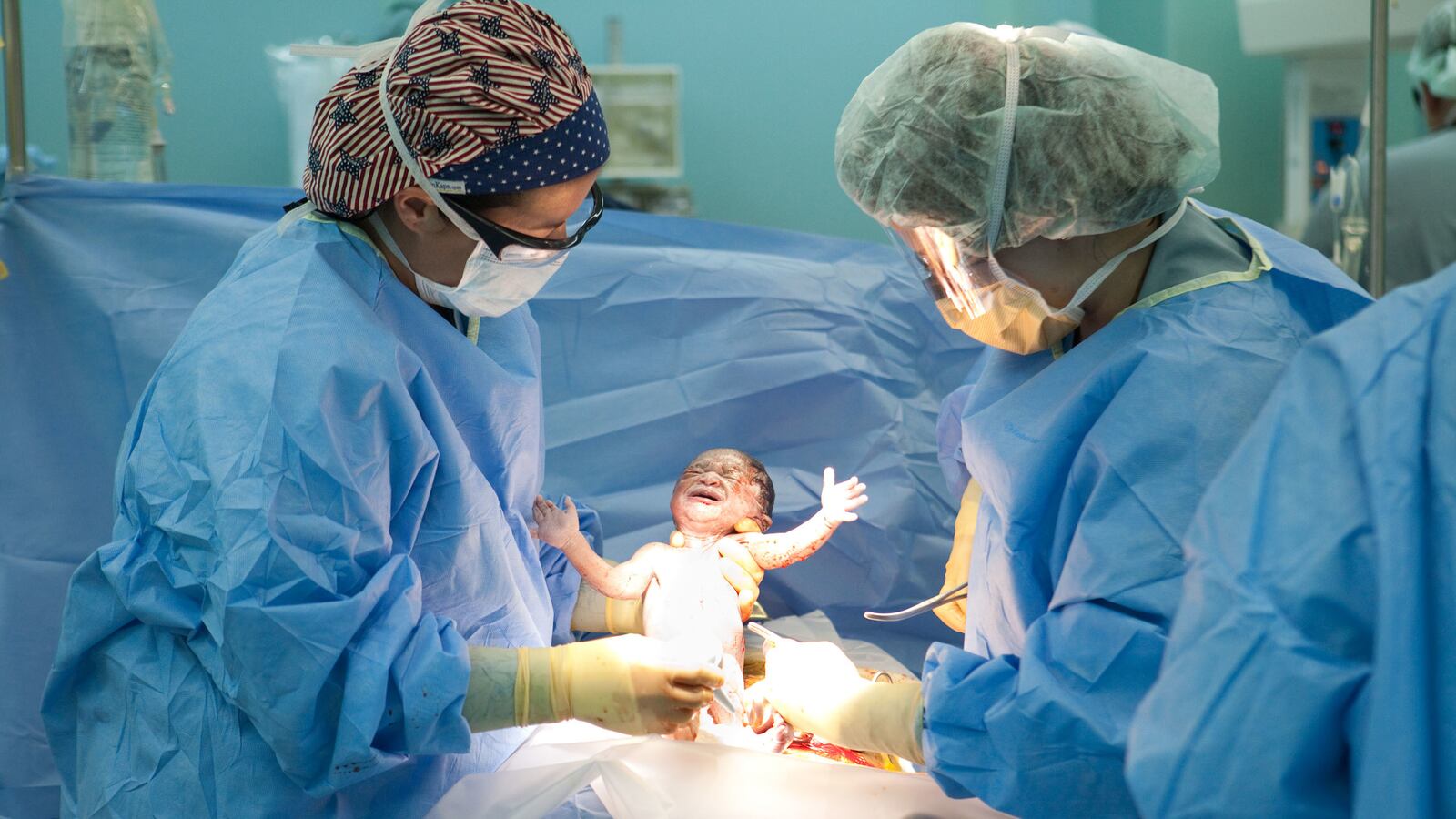Hours before Rinat Dray gave birth, she was scared and struggling, not in labor but in a dispute with her OB-GYN, Dr. Leonid Gorelik. He had threatened to stop examining her if she continued to refuse a caesarean section. “He was pressing me hard. He put the glove on to see how dilated I am,” she says, her voice still shaky nearly three years after her July 26, 2011 delivery at Staten Island University Hospital. “He took it out and then he said, ‘I’m not going to check you unless you sign for the C-section.’”

Dray's delivery process was becoming a nightmare. After two previous C-sections, this was exactly what she wanted to avoid with her third pregnancy, and she felt she and her baby were OK. “I was feeling the baby. I could feel his heartbeats, and I was sure he was fine. I just thought he needed more time,” she says. But Gorelik was having none of it. According to Dray, he told her that “my progress was fine, but he just doesn’t have all day for me.” When both she and her mother begged him to reconsider the C-section, “He said, ‘I’m not bargaining.’” And she remembers that “right before he started, he said ‘Don't speak.’”Dray had chosen Staten Island University Hospital precisely because of their relatively low C-section rates. When I meet with Dray, she is dressed incredibly modestly from ankles to neck in black, a mark of her membership in the Chabad Lubovich movement, a sect of Orthodox Judaism. She had no intention of stopping at her third pregnancy at 32 and hoped to have one of the traditional large families that are valued within her community. After three C-sections, pregnancy carries greater risks. Therefore, Dray actively sought a hospital that would be supportive of her decision to avoid another C-section.New York is one of only two states that mandates that hospitals publish their C-section rates. In 2011 Staten Island University Hospital’s C-section rate was 23.1 percent, significantly lower than the state’s 34.3 percent average. In particular, Dray selected the hospital because she had heard that they were encouraging of vaginal birth after cesarean (VBAC). Years ago, it was believed that once a woman had a C-section, that was the only way to continue deliveries. However, according to the Mayo Clinic, 75 percent of VBAC attempts are successful. Dray says that the doctors she had seen in the practice prior to her delivery were, in fact, supportive of her VBAC plan.Still, even Staten Island University Hospital’s rate exceeds the World Health Organization’s recommended C-section rate of no more than 15 percent per nation. According to the Centers for Disease Control, the U.S. rate is a whopping 32.8 percent.It’s no secret that, as Dray’s lawyer Michael Bast says, “There is a national epidemic of C-sections.” A number of reasons have been suggested for this problem; few of them make doctors or hospitals look particularly good. Some economists have suggested financial incentives may be at play; a 2013 paper by the National Bureau of Economic Research determined doctors make a few hundred dollars more and hospitals make a few thousand dollars more for C-sections versus vaginal deliveries. That same paper found doctors were less likely to perform C-sections on mothers who were doctors, which they hypothesized was because medical knowledge made them less resistant to pressure. Malpractice fears may be another factor, with some physicians believing that they better protect themselves from financial loss in court by showing they performed a C-section. Some have also argued that time constraints may be an issue. New guidelines released by the American College of Obstetricians and Gynecologists and the Society for Maternal-Fetal Medicine in 2014 suggest a normal delivery actually takes longer than doctors once believed it should be. Well-intentioned physicians may be concerned and rush to convince patients to have C-sections. Or, they may be less benevolent, as Dray believes Gorelik was. She claims “He said clearly, ‘I don’t have all day for you.’”Dray says she never once consented to the C-section and even contemplated fleeing the hospital. “I thought maybe I should try to run away from there. I was scared, and I just kept begging him all the way, and he wouldn’t listen,” she says. Unfortunately, she had every right to be concerned. The C-section did not go smoothly. Her bladder was perforated during her surgery.While this injury is part of the basis for her suit against Gorelik, Dr. James J. Ducey (the director of the hospital’s Maternal/Fetal Medicine Department), and the hospital itself, the most disturbing claim is that her C-section refusal was ignored. Dray’s case is striking because the hospital documented in the progress notes that doctors were aware that she had refused permission to perform the C-section. Ducey’s notes from July 26, 2011 at 2:30 p.m. state: The woman has decisional capacity. I have decided to override her refusal to have a C-section. Her physician, Dr. Gorelik, and hospital attorney, Mr. Fried, are in agreement.New York State’s Patient Bill of Rights explicitly states that a patient has the right to “refuse treatment.” This shouldn’t be terribly shocking to Americans. The right to refuse treatment “is universally recognized as a fundamental principle of liberty,” stated an editorial in the American Journal of Public Health.However, when it comes to pregnant women, there is an unfortunate history of the medical community violating their rights as patients. There are multiple cases of pregnant women who are treated as if they have rescinded their right to make choices once they have decided to carry a fetus.Though she had an attorney and even the American Civil Liberties Union on her side, Angela Carder is one of the most egregious and tragic examples of a forced C-section. In 1987, after two previous bouts of cancer, she was diagnosed with the disease again while 26 weeks pregnant. She was told she had two weeks left to live, and she decided that rather than undergo a risky and painful C-section, she would go through whatever medical treatments were possible with the hope of living “long enough to hold that baby,” said her mother. Hospital administrators ignored her request and rushed her into a forced C-section. Though the ACLU tried to get the District of Columbia Court of Appeals to block the order, the three-judge panel refused to interfere and later upheld the order. Carder’s baby girl died two hours later. It was one of Carder’s last memories, two days before her own death.
The National Advocates of Pregnant Women (NAPW) studied over 400 cases of pregnant women whose rights as patients were violated because they were carrying their fetuses to term. The report includes the case of Laura Pemberton, a pregnant woman who in 1999 wanted to deliver her baby vaginally from her home. Doctors received a court order to force her to have a C-section and, according to the NAPW report, the “sheriff went to Pemberton’s home, took her into custody, strapped her legs together, and forced her to go to a hospital, where an emergency hearing was under way to determine the state’s interest in protecting the fetus still inside her.” The fetus was granted a lawyer by the court, but Pemberton and her husband were not.Farah Diaz-Tello, a staff attorney for the NAPW, says that an underlying theme in cases of forced C-sections is “a push to treat fertilized eggs, embryos, and fetuses as though they are separate legally separated from the woman who carries them.”Forced C-section debates often skirt or even devolve into a proxy pro-choice/pro-life debate, explains Diaz-Tello. “When courts grant orders for cesarean surgery they often do so in reference to anti-abortion measures and a misinterpretation of Roe v. Wade,” she says. “What is happening is that when they cite Roe v. Wade, they cite it to say that at a point when a woman is carrying a viable pregnancy, she loses all of her rights, not just to an abortion.” As shown in Pemberton's case, in the worst situations, “an attorney is appointed for the fetus and for the hospital, but the woman herself is not guaranteed counsel, and she is left to defend herself in active labor,” says Diaz-Tello.Dray was not given a patient advocate nor did she have any consultations regarding her legal rights prior to the C-section. She still insists she refused the C-section throughout the delivery, even as she was pushed into the operating room. Dr. Gorelik’s lawyer did not respond for comment by the time this article went to press. In court papers, he has stated that any of Dray’s injuries were due to “culpable conduct and want of care.” Staten Island University Hospital provided a statement saying it “cannot comment on pending litigation and patient privacy,” but stressed that it recognizes “every patient’s condition is unique, and [they] approach every decision to what is medically necessary for the health and well-being of the mother and the baby.” The hospital also cited its relatively low C-section rates and relatively high VBAC rates (28.5 percent as compared to the national rate of 11.3 percent). While impressive, these figures are largely irrelevant for Dray. She chose the hospital because she believed these rates were proof she would have the delivery she wanted. Instead, the rest of her life as a mother has been dramatically restricted, despite the hospital’s reputation.Dray glances at me and then looks away when I ask her if she is going to have any more children.“It is very scary after,” she explains. “When I was in the hospital, a physician’s assistant came and told me, ‘They’re going to come and explain you shouldn’t have any more children.’ Later on they came and said something else, but a midwife later told me the same [not to have more children]. That it’s too dangerous. I wish I could have more.” She pauses for a while and whispers, “I don’t know what to do.”Dray’s son, Yosef, from that July 2011 delivery is healthy, but that is not enough to satisfy her. The disappointment and trauma of her experience radiates through her shaky voice, but it steadies when she talks about the potential to help another mother.“It should not be this way," she says. "If I tell others, then maybe things will change. I couldn’t just let it go. It should not happen again to any other woman.”






